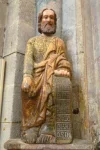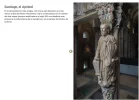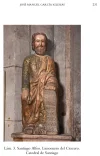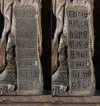Bert45, to my chagrin, I don't speak or read Latin, but perhaps I can help get you started. At the following link you will find this article:
SANTIAGO DE COMPOSTELA Y LA DEVOCIÓN AL APÓSTOL SANTIAGO ALFEO, LA OTRA FAZ DEL CULTO JACOBEO by José Manuel García Iglesias of the Universidad de Santiago de Compostela
Using the pagination of the article, scroll to page 231 where you will find this picture:
View attachment 114033
At page 216 of that article there is the following Spanish sentence:
Un Santiago el Menor sedente se presenta en el crucero de la catedral, en su lado norte, arrimado al pilar toral, sobre un limosnero. Está figura despliega un texto, en una cartela, que dice: «ECCE
ARCA HOPERIS BEATI IACOBI APOSTOLI»
Using various translation tools, I get the following very rough translation of the Spanish. (From your original post, I assume the word "beggar" below refers to the offertory box--or perhaps there is a beggar below the statue.)
A seated Santiago el Minor appears on the transept of the cathedral, on its north side, leaning against the main pillar, over a beggar. This figure displays a text, on a cartouche, that says: ECCE ARCA HOPERIS BEATI IACOBI APOSTOLI.
The Latin is translated as: "
Behold the ark of the work of Blessed James the Apostle."
The problem I have is that I cannot tell from the article if the referenced text refers to the text shown in the above-inserted picture which is identified as "Lam. 3." Someone who reads Latin should be able to solve the puzzle.
Bueno suerte!

























